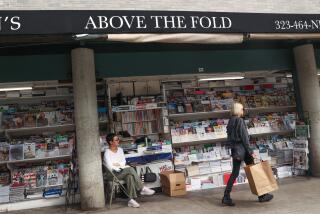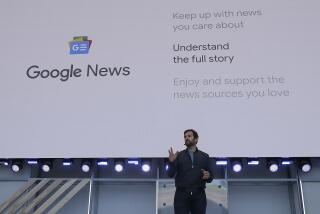Sadly, the bottom line counts
One of my first editors would visibly recoil when the newspaperâs ad manager occasionally ventured into the newsroom.
âHere they come. Here come the ad goons,â the white-haired newsman would growl, before bellowing at the offender (in more florid language than this paper allows): âStay the heck out of our side of the building, will ya?â
Man, did we love that.
The old Irishman lacked subtlety. But he made us feel the news wouldnât be subjected to undue influence from anyone, including those trying to make the paper a buck.
In that earlier epoch newspapers were fat, virtually monopolizing local and classified advertising. Now newspaper people track their falling fortunes daily and talk about âmonetizing contentâ on the Web.
The debate has gotten tiresome and dispiriting. Itâs gotten so bad, reporter Brenda Starr, a comic creation, is getting furloughed. Portland news-folk applauded the boss the other day for merely announcing: âWe do intend to keep publishing the Oregonian.â
The recession has turned a painful evolution into life-threatening revolution.
Whatâs most difficult for old-schoolers to accept, Internet strategist Clay Shirky noted in a recent essay, is that âthe old stuff gets broken faster than the new stuff is put in its place.â
When we insist on knowing the new media models before the old ones crumble, Shirky wrote, we are âdemanding to be lied to.â
So Iâm embracing uncertainty. Both because what Shirky said makes sense and because a recent flurry of proposals -- which tend toward begging for charity or forcing users to pay for Web content -- have limited potential.
Former Time managing editor Walter Isaacson kicked off a wave of soul-searching about funding the newspaper business last month with his story on the magazine cover. It called on newspapers to charge readers via iTunes-style âmicro-paymentsâ for their information online.
Similar proposals followed, most saying the audience could pay through user-friendly one-click debits or cable television-style subscriptions.
But pay-to-view models are leaning into a strong, strong wind for free Internet content. Most newspapers that charged for online content, including this one and the New York Times, dropped the experiment.
Iâd argue as furiously as anyone that newspapers routinely deliver the bulk of the compelling, and accurate, information in marketplace.
But Iâm afraid most consumers just want the City Council vote or the ball score. They donât care to pay for the analysis, pretty turn of phrase or killer photograph that papers add to the mix.
âItâs the challenge of âgood enough,â â the chief executive of a large newspaper chain told me. âIf you charge for content, the audience will go to something not as good, but good enough. In most markets that would mean a TV or radio website.â
Another school argues that foundations and civic-minded individuals can be persuaded to pick up the slack. Upstart websites in Minneapolis, San Diego and other cities are showing that charitable donations can pay for good journalism. For three decades, the nonprofit Poynter Institute has owned the St. Petersburg Times.
But the deep-pocketed benefactors wonât be found in all cities.
And even the St. Pete Times, with its not-for-profit ownership, has needed to lure sufficient ad money to keep its franchise healthy.
The challenges from the Web and the dreary economy have forced it to slash its news staff and put its most lucrative franchise, Congressional Quarterly, up for sale.
Translation: Charity can carry the news business only so far.
One group of newspaper veterans who see grave limits in the nonprofit and pay-for-content models has proposed a third way -- repackaging and improving paid online advertising.
âThe advertising industry is still paying billions of dollars to reach people. We have to continue to be part of that,â said Alan Jacobson, the newspaper design consultant who helped form a volunteer group RevenueTwoPointZero.
The group met in Washington last week and came up with prototypes for new advertising.
One envisions beating craigslist at its own game, by offering mostly free classified ad listings.
The newspaper people think they might even jump-start their classified volume by aggregating Craigâs voluminous listings, then adding their own.
Money would be made, the TwoPointZero organizers believe, by selling a few preferred classified listing positions, along with advertising for related products. (Car dealers might pay to place an ad, for example, alongside free classifieds for used cars.)
Jacobsonâs group would kill many of the pop-up and video ads that now pester readers as they try to access stories and pictures. He would replace them with large, bold display ads that would fit on most computersâ wide margins.
Customers might be lured to ads that feature clever animation or sound, instead of feeling they were being force-fed. (Think the âDaily Prophetâ newspaper of âHarry Potterâ fame, Jacobson muses.)
My guess is that charity will support a few news outlets and individual journalists. And readers might pay for some premium content, particularly if itâs tailored to their specific interests.
A continued contraction of our business seems inevitable, but Iâd guess enough advertising will be found to propel a good dose of general interest news gathering into a new era.
We need some clever and energetic advertising executives to help figure it out, Iâll admit.
Though it sure was a lot more fun in those monopoly days, when we could afford to believe that only âgoonsâ worried about making a buck.
--
More to Read
Sign up for Essential California
The most important California stories and recommendations in your inbox every morning.
You may occasionally receive promotional content from the Los Angeles Times.











